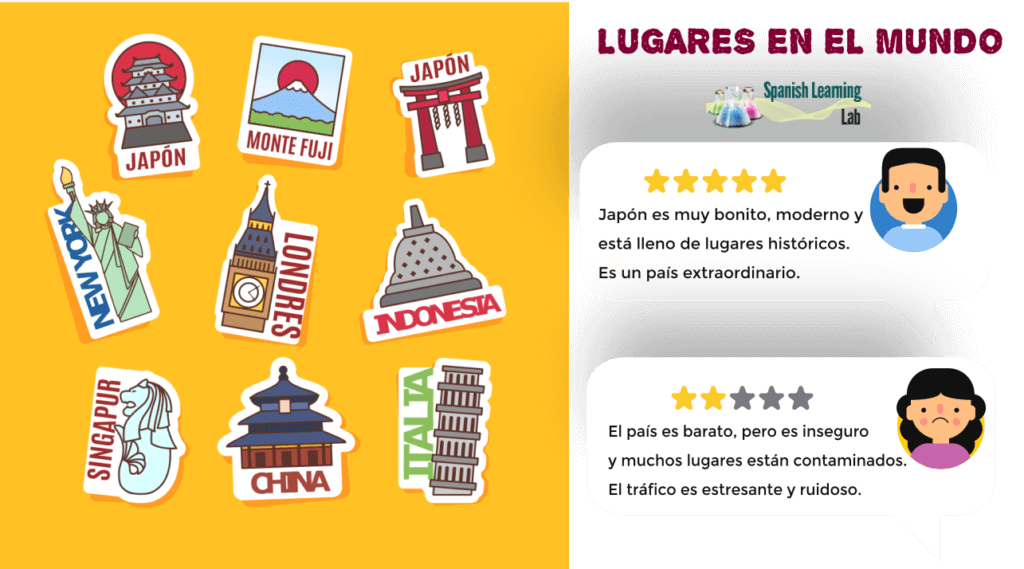¡Hola! Thanks for joining us in this lesson. This time, we will present a list of adjectives that are frequently used to recommend places in Spanish and describe cities in the language. We’ll also cover some specific phrases and questions about this topic, which will also be used in two interesting listening activities. Let’s start…

Vocabulary and Grammar: Adjectives and ways to give suggestions.
First of all, adverbs can be used to make our descriptions sound better. They will be used before adjectives, just like their counterpart in English. This way, we could make sentences like: “Venecia es extremadamente bonito” where “extremadamente” is an adverb and “bonito” is an adjective. These adverbs are words like:
extremadamente, muy, realmente, bastante, algo, un poquito y demasiado.
Please read and listen to the first group of examples using adjectives and adverbs to describe places and cities in Spanish:
|
Bonito – Singapur es un país muy bonito y moderno.
Beautiful – Singapore is a very beautiful and modern country.
|
|
Feo – El hostal es feo y los cuartos son bastante incómodos.
Ugly – The hostel is ugly and the rooms are quite uncomfortable.
|
|
Interesante – Hay muchos lugares interesantes que visitar en Japón.
Interesting – There are many interesting places to visit in Japan.
|
|
Aburrido – El tour por la ciudad estuvo bastante aburrido.
Bored – The city tour was pretty boring.
|
|
Barato – La comida en los mercados nocturnos es extremadamente barata.
Cheap – Food at night markets is extremely cheap.
|
|
Caro – La ropa de marcas famosas es algo cara en Nueva York.
Expensive – Famous brand clothing is expensive in New York.
|
|
Calmo – Las playas del caribe son muy calmas y llenas de vida.
Calm – Caribbean beaches are very calm and full of life.
|
|
Ruidoso – La capital de México es realmente ruidosa.
Noisy – The capital of Mexico is really noisy.
|
|
Relajante – El clima en las montañas de Perú es relajante.
Relaxing – The weather in the mountains of Peru is relaxing.
|
|
Estresante – El transporte público de ese país es un poquito estresante.
Stressful – Public transportation in that country is a little bit stressful.
|
Second, we always use the equivalent of SHOULD, that is DEBERÍA, to give suggestions in Spanish. We form “DEBERÍA” by adding the suffix -ÍA to the verb DEBER, which will transform it into a suggestion. In addition to DEBERÍA, the verbs “SUGERIR” and “RECOMENDAR” can be used the same way to recommend places in Spanish, adding or omitting the suffix “-ÍA” . Both SUGERIR and RECOMENDAR will need an indirect object pronoun to indicate who is being advised, that is words like “me, te, se, le” and so on.
Pay attention to the next group of sample sentences and ways to give suggestions in Spanish:
| Seguro – Incluso si un lugar es seguro, deberías ser cuidadoso al visitarlo Safe – Even if a place is safe, you should be careful when visiting it |
|
Peligroso – Te sugiero ir a un lugar menos peligroso para nadar.
Dangerous – I suggest you go to a less dangerous place to swim.
|
|
Espacioso – Te recomiendo visitar lugares espaciosos y naturales.
Spacious – I recommend you visit spacious and natural places..
|
|
Concurrido – ¿Tú crees que debería ir a este lugar? He escuchado que es muy concurrido.
Crowded – Do you think I should go to this place? I have heard that it is very crowded.
|
|
Limpio – Deberíamos mantener todos los lugares naturales limpios.
Clean – We should keep all natural places clean.
|
|
Contaminado – Los ríos y lagos del país están contaminados. No deberías nadar en ellos.
Polluted – The rivers and lakes of that country are polluted. You shouldn’t swim there.
|
|
Antiguo – Te recomendaría visitar el museo antiguo en el centro de la ciudad.
Ancient – I would recommend visiting the ancient museum in the city center.
|
|
Moderno – Hay varios lugares modernos en la parte sur de la ciudad. Deberías visitarlos.
Modern – There are several modern places in the southern part of the city. You should visit them.
|
|
Histórico – Te sugiero conocer estos lugares históricos antes de ir a otra ciudad.
Historical – I suggest you get to know these historical places before going to another city.
|
|
Emocionante – Deberías ir a un lugar más emocionante en tus próximas vacaciones.
Exciting – You should go to a more exciting place on your next vacation.
|
Listening Activity No. 1: Talking about cities around the world in Spanish
Listening Activity No. 2: Recommending places to visit in Spanish
Thanks for making it to the end of this lesson. Please keep on practicing ways to describe towns and recommend places in Spanish. It’s a good idea to check online reviews for places in Spanish to see other adjectives and structures in use. Also, check other lessons to learn more about other topics, including common places in town and more. ¡Hasta la próxima!
Related Spanish worksheets:
- Giving directions in Spanish – Dialogue worksheet
- Places in the City in Spanish – PDF Worksheet
- Adjectives to Describe Places in Spanish
- Giving Directions in Spanish
- Giving directions in Spanish – Dialogues
- Asking for Directions in Spanish
- Our Travel Experiences in Spanish – PDF Reading Worksheet
- A Historic Neighborhood in Spanish – PDF Reading Worksheet
- Let’s talk about Travel in Spanish – Conversation cards
- Around the Streets in Spanish
- Impressive Places and Superlatives in Spanish (Reading exercises)
- The History of Transportation in Spanish (Reading)
